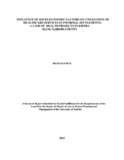| dc.description.abstract | This research sought to demystify the influence of socio-economic factors on utilization of
healthcare services in Kenya’s informal settlements using community health projects in Kibera
slum in Nairobi County. The study sought to investigate the five related objectives which
included: to examine the influence of levels of income on health-care seeking behavior in
informal settlements in Kenya, to establish the influence of literacy levels on health-care seeking
behavior in informal settlements in Kenya, to verify the influence of levels of poverty on healthcare
seeking behavior in informal settlements in Kenya, ascertain the influence of gender on
health-care seeking behavior on informal settlements in Kenya and to determine the combined
influence of socio-economic factors on health-care seeking behavior in informal settlements in
Kenya. The study delimited itself to the four ongoing projects which included Kibera Water and
Sanitation Project, Kibera Global Giving Project, Kibera Community Integrated Health Program
and Kibera Better Options Project. The target population for this study was 500 households
supported by the four projects under study. The sample size for this study was 154
households that were determined by the use of the simplified Yamane, (1967) formula of
proportions. A structured questionnaire was the main tool used to collect the required data.
The structured questionnaire contained 6 sections with 15 questions. The validity of the
questionnaire was established through construct validity while reliability of the questionnaire was
established through Cronbach’s Alpha and found to be 0.7475 meaning the questionnaire was
therefore reliable. Pilot-testing of the questionnaire was undertaken on households in Mashimoni
village that were deliberately excluded from the main study. Pilot testing process was crucial in
helping to refine the questionnaire mechanics and remove inconsistencies and errors. This
research adopted descriptive survey design so as to describe the characteristics of targeted
households, estimate the proportion of people with certain characteristics and make predictions
on utilization of healthcare services. This design was used due to its ability to ensure
minimization of bias and maximization of the reliability of evidence so collected. Data obtained
was analyzed using statistical package for social sciences (SPSS) Version 21.0.Qualitative data
was analyzed by making inferences from expressions and opinions of the respondents around the
themes and presented descriptively through content analysis. Findings were presented in
frequency tables and explanations followed in prose. From the regression models undertaken
there was a highly significant relationship (with t statistic p value <0.001 < 0.05) between the
level of income and utilization of healthcare services. Again there existed a highly significant
relationship (with t statistic p value <0.0035 < 0.05) between level of poverty and the utilization
of health care services. There was somewhat significant relationship significant relationship (with
t statistic p value <0.0045 < 0.05) between literacy level and the utilization of healthcare services.
However there was no any relationship between gender (p = 0.220 > 0.05) and the utilization of
healthcare services. Meaning this study adopts accept the 1st, 2nd and 3rd hypothesis and rejects the
4th hypotheses respectively. From the multiple regression model, this relationship is depicted as
Y= 4.00+ 0.001X1+ 0.0035X2+ 0.0045X3+ 0.220X4 +B0. In essence therefore, this study
recommends that deliberate efforts should be placed on income levels, boosting literacy and
reduction of poverty levels if utilization of health care services is to improve in informal
settlements in Kenya. | en_US |

